(完整版)初中现在进行时和过去进行时知识点和题(精心总结)
- 格式:doc
- 大小:48.01 KB
- 文档页数:8
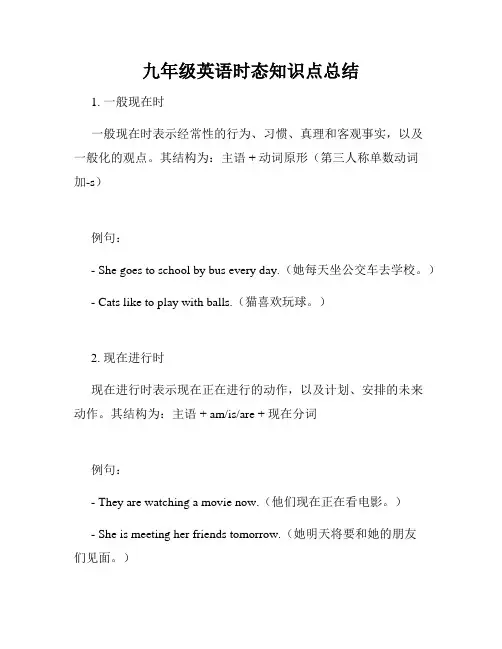
九年级英语时态知识点总结1. 一般现在时一般现在时表示经常性的行为、习惯、真理和客观事实,以及一般化的观点。
其结构为:主语 + 动词原形(第三人称单数动词加-s)例句:- She goes to school by bus every day.(她每天坐公交车去学校。
)- Cats like to play with balls.(猫喜欢玩球。
)2. 现在进行时现在进行时表示现在正在进行的动作,以及计划、安排的未来动作。
其结构为:主语 + am/is/are + 现在分词例句:- They are watching a movie now.(他们现在正在看电影。
)- She is meeting her friends tomorrow.(她明天将要和她的朋友们见面。
)3. 一般过去时一般过去时表示过去发生的动作或状态。
其结构为:主语 + 动词过去式例句:- We went to the beach last summer.(我们去年夏天去了海滩。
)- He studied hard for the test.(他为了考试努力学习。
)4. 过去进行时过去进行时表示过去某个时间段正在进行的动作。
其结构为:主语 + was/were + 现在分词例句:- They were playing soccer when it started raining.(下雨时他们正在踢足球。
)- I was studying in the library yesterday afternoon.(昨天下午我在图书馆学习。
)5. 一般将来时一般将来时表示将来某个时间要发生的动作。
其结构为:主语+ will + 动词原形例句:- We will have a party next week.(我们下周要开派对。
)- She will visit her grandparents this weekend.(她这个周末要去看望她的祖父母。
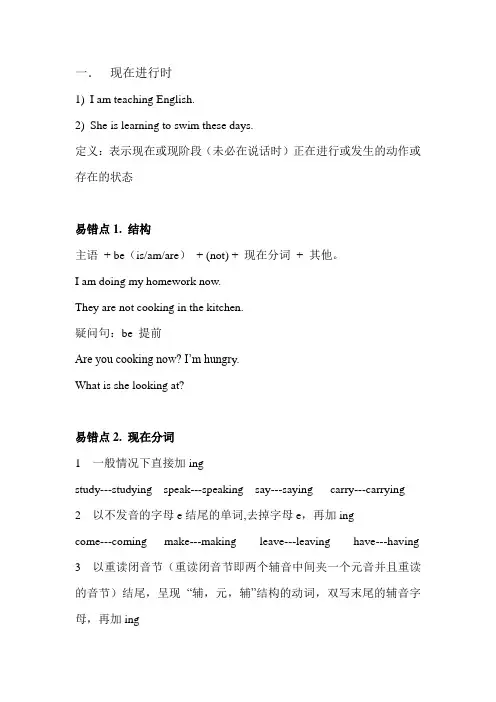
一.现在进行时1)I am teaching English.2)She is learning to swim these days.定义:表示现在或现阶段(未必在说话时)正在进行或发生的动作或存在的状态易错点1. 结构主语+ be(is/am/are)+ (not) + 现在分词+ 其他。
I am doing my homework now.They are not cooking in the kitchen.疑问句:be 提前Are you cooking now? I’m hungr y.What is she looking at?易错点2. 现在分词1 一般情况下直接加ingstudy---studying speak---speaking say---saying carry---carrying2 以不发音的字母e结尾的单词,去掉字母e,再加ingcome---coming make---making leave---leaving have---having 3 以重读闭音节(重读闭音节即两个辅音中间夹一个元音并且重读的音节)结尾,呈现“辅,元,辅”结构的动词,双写末尾的辅音字母,再加ingstop---stopping sit---sitting run---running forget---forgetting begin---beginning这类词还有:cut, get, hit, run, set, sit, spit, stop, swim, beg, drop, fit, nod, dig, forget, regret, rid, 等。
把ie改y再加ing4. die---dying tie---tying lie---lying易错点3. 时间状语时间类:now, at this moment, at present, in this month,these days情境类:Look! Listen! Be careful!Where is Tom? I can’t find him.Is there raincoat yours?eg: At the (this) moment, he is only weeping.Look! My mother is running!!!Listen! They are reading.Be careful! The car is running at you.---Where is Tom? I can’t find him.---He is playing games.---Is there raincoat yours?---Mine is hanging out here.易错点4.特殊用法与always, constantly, forvever 等词连用,表示反复发生的动作或存在的状态,往往带有说话人的主观色彩,讨厌,憎恨,惊讶,喜欢等You are always changing your mind.He is often playing the guitar. I can’t focus.现在进行时表将来, 马上,按计划将要发生的事情来来去去开始停止死come, arrive, go, leave, begin, start, stop, dieThe bus is coming.I’m going home in half an hour.我一个半小时内要回家。
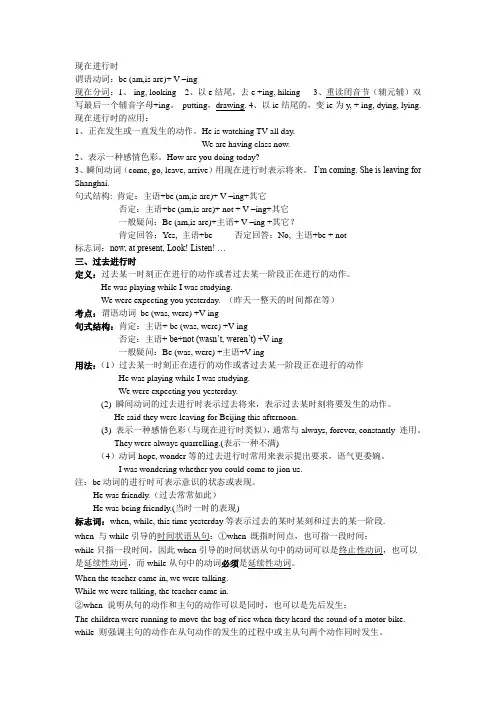
现在进行时谓语动词:be (am,is are)+ V –ing现在分词:1、-ing, looking 2、以e结尾,去e +ing, hiking 3、重读闭音节(辅元辅)双写最后一个辅音字母+ing。
putting,drawing. 4、以ie结尾的,变ie为y, + ing, dying, lying. 现在进行时的应用:1、正在发生或一直发生的动作。
He is watching TV all day.We are having class now.2、表示一种感情色彩。
How are you doing today?3、瞬间动词(come, go, leave, arrive)用现在进行时表示将来。
I’m coming. She is leaving for Shanghai.句式结构: 肯定:主语+be (am,is are)+ V –ing+其它否定:主语+be (am,is are)+ not + V –ing+其它一般疑问:Be (am,is are)+主语+ V –ing +其它?肯定回答:Yes, 主语+be 否定回答:No, 主语+be + not标志词:now, at present, Look! Listen! …三、过去进行时定义:过去某一时刻正在进行的动作或者过去某一阶段正在进行的动作。
He was playing while I was studying.We were expecting you yesterday. (昨天一整天的时间都在等)考点:谓语动词be (was, were) +V-ing句式结构:肯定:主语+ be (was, were) +V-ing否定:主语+ be+not (wasn’t, weren’t) +V-ing一般疑问:Be (was, were) +主语+V-ing用法:(1)过去某一时刻正在进行的动作或者过去某一阶段正在进行的动作He was playing while I was studying.We were expecting you yesterday.(2) 瞬间动词的过去进行时表示过去将来,表示过去某时刻将要发生的动作。
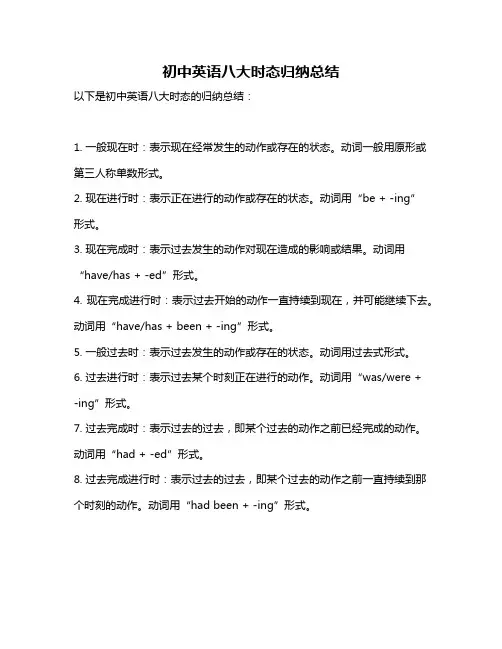
初中英语八大时态归纳总结
以下是初中英语八大时态的归纳总结:
1. 一般现在时:表示现在经常发生的动作或存在的状态。
动词一般用原形或第三人称单数形式。
2. 现在进行时:表示正在进行的动作或存在的状态。
动词用“be + -ing”
形式。
3. 现在完成时:表示过去发生的动作对现在造成的影响或结果。
动词用“have/has + -ed”形式。
4. 现在完成进行时:表示过去开始的动作一直持续到现在,并可能继续下去。
动词用“have/has + been + -ing”形式。
5. 一般过去时:表示过去发生的动作或存在的状态。
动词用过去式形式。
6. 过去进行时:表示过去某个时刻正在进行的动作。
动词用“was/were + -ing”形式。
7. 过去完成时:表示过去的过去,即某个过去的动作之前已经完成的动作。
动词用“had + -ed”形式。
8. 过去完成进行时:表示过去的过去,即某个过去的动作之前一直持续到那个时刻的动作。
动词用“had been + -ing”形式。
以上是初中英语的八大时态,理解和掌握这些时态对于英语学习和交流非常重要。
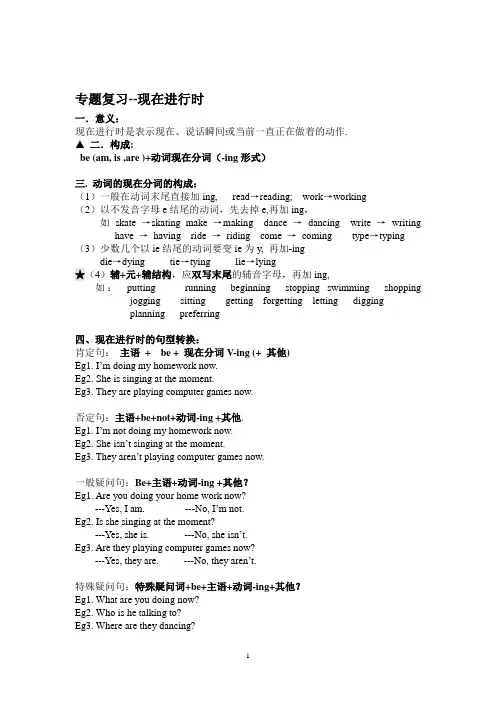
专题复习--现在进行时一.意义:现在进行时是表示现在、说话瞬间或当前一直正在做着的动作.▲二.构成:be (am, is ,are )+动词现在分词(-ing形式)三. 动词的现在分词的构成:(1)一般在动词末尾直接加ing, read→reading; work→working(2)以不发音字母e结尾的动词,先去掉e,再加ing,如skate →skating make →making dance →dancing write →writing have →having ride →riding come →coming type→typing (3)少数几个以ie结尾的动词要变ie为y, 再加-ingdie→dying tie→tying lie→lying★(4)辅+元+辅结构,应双写末尾的辅音字母,再加ing,如:putting running beginning stopping swimming shopping jogging sitting getting forgetting letting diggingplanning preferring四、现在进行时的句型转换:肯定句:主语+ be + 现在分词V-ing (+ 其他)Eg1. I’m doing my homework now.Eg2. She is singing at the moment.Eg3. They are playing computer games now.否定句:主语+be+not+动词-ing +其他.Eg1. I’m not doing my homework now.Eg2. She isn’t singing at the moment.Eg3. They aren’t playing computer games now.一般疑问句:Be+主语+动词-ing +其他?Eg1. Are you doing your home work now?---Yes, I am. ---No, I’m not.Eg2. Is she singing at the moment?---Yes, she is. ---No, she isn’t.Eg3. Are they playing computer games now?---Yes, they are. ---No, they aren’t.特殊疑问句:特殊疑问词+be+主语+动词-ing+其他?Eg1. What are you doing now?Eg2. Who is he talking to?Eg3. Where are they dancing?五、现在进行时的时间标志及用法:1)一般句中用到表示“在现在”的时间状语,如:now, right now, at the moment 或It’s+几点钟”句型,常判断用现在进行时。
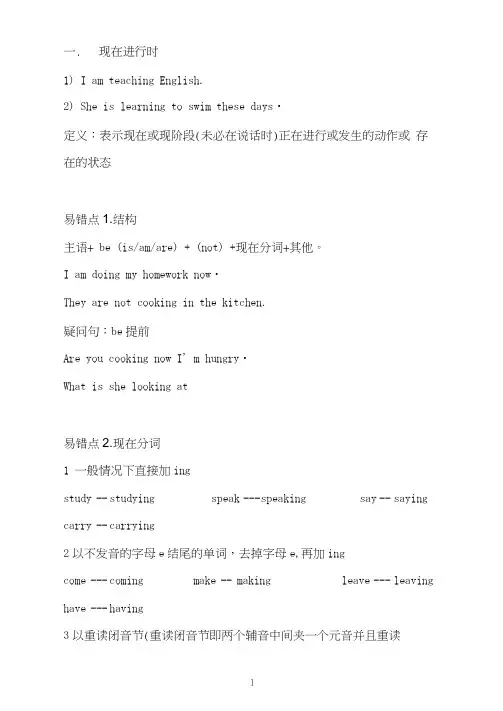
一. 现在进行时1) I am teaching English.2) She is learning to swim these days・定义:表示现在或现阶段(未必在说话时)正在进行或发生的动作或存在的状态易错点1.结构主语+ be (is/am/are) + (not) +现在分词+其他。
I am doing my homework now・They are not cooking in the kitchen.疑问句:be提前Are you cooking now I' m hungry・What is she looking at易错点2.现在分词1 一般情况下直接加ingstudy -- studying speak --- s peaking say -- saying carry -- carrying2以不发音的字母e结尾的单词,去掉字母e,再加ingcome --- coming make -- making leave --- leaving have --- having3以重读闭音节(重读闭音节即两个辅音中间夹一个元音并且重读的音节)结尾,呈现“辅,元,辅”结构的动词,双写末尾的辅音字母,再加ingstop st opp ing sit sitting run running forget --- f orgetting begin ------ beginning 这类词还有:cut, get, hit, run, set, sit, spit, stop, swim, beg, drop, fit, nod, dig, forget, regret, rid,等。
把ie改y再加ing4.die --- d ying tie ----- tying lie -----lying易错点3.时间状语时间类:now, at this moment, at present, in this month, these days情境类:Look! Listen! Be careful!Where is Tom I can, t find him・Is there raincoat yourseg: At the (this) moment, he is only weeping.Look! My mother is running!!!Listen! They are reading・Be careful! The car is running at you・-- Where is Tom I can* t find him.-- He is playing games.-- Is there raincoat yours-- Mine is hanging out here.易错点4.特殊用法与always, constantly, forvever等词连用,表示反复发生的动作或存在的状态,往往带有说话人的主观色彩,讨厌,憎恨,惊讶,喜欢等You are always changing your mind・He is often playing the guitar. I can* t focus・现在进行时表将来,马上,按计划将要发生的事情来来去去开始停止死come, arrive, go, leave, begin, start, stop, dieThe bus is coming・I' m going home in half an hour.我一个半小时内要回家。
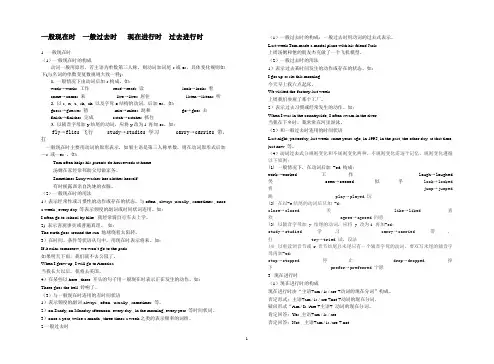
一般现在时一般过去时现在进行时过去进行时1. 一般现在时(1)一般现在时的构成动词一般用原形,若主语为单数第三人称,则动词加词尾-s或-es,具体变化规则如下(与名词的单数变复数规则大致一样):1.一般情况下由动词后加-s构成。
如:work→works 工作read→reads 读look→looks 看come→comes 来live→lives 居住listen→listens 听2.以s, x, z, sh, ch 以及字母o结构的动词,后加-es。
如:guess→guesses 猜mix→mixes 混和go→goes 去finish→finishes 完成catch→catches 抓住3.以辅音字母加y结尾的动词,应将y改为i 再加-es。
如:fly→flies 飞行study→studies 学习carry→carries 带,扛一般现在时主要用动词的原形表示,如果主语是第三人称单数,则在动词原形式后加—s 或—es 。
如:Tom often helps his parents do housework at home.汤姆在家经常邦助父母做家务。
Sometimes Lucy washes her clothes herself.有时候露西亲自洗她的衣服。
(2)一般现在时的用法1)表示经常性或习惯性的动作或存在的状态。
与often , always ,usually , sometimes , once a week , every day 等表示频度的副词或时间状词连用。
如:I often go to school by bike. 我经常骑自行车去上学。
2) 表示客观事实或普遍真理。
如:The earth goes around the sun .地球绕着太阳转。
3)在时间、条件等状语从句中,用现在时表示将来。
如:If it rains tomorrow, we won’t go to the park.如果明天下雨,我们就不去公园了。
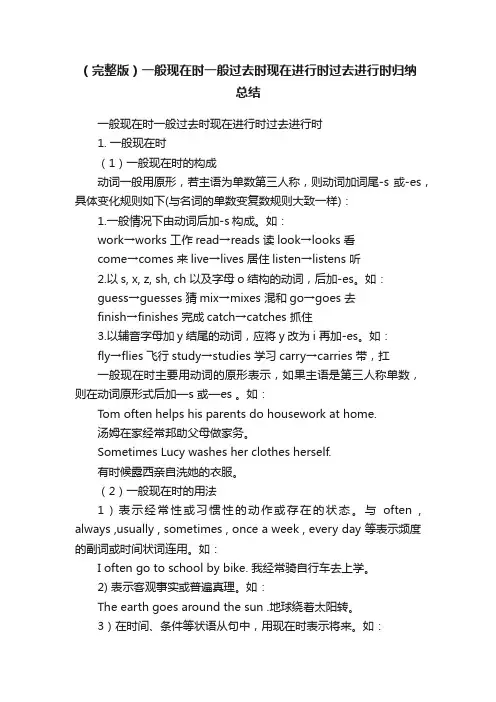
(完整版)一般现在时一般过去时现在进行时过去进行时归纳总结一般现在时一般过去时现在进行时过去进行时1. 一般现在时(1)一般现在时的构成动词一般用原形,若主语为单数第三人称,则动词加词尾-s或-es,具体变化规则如下(与名词的单数变复数规则大致一样):1.一般情况下由动词后加-s构成。
如:work→works 工作read→reads 读look→looks 看come→comes 来live→lives 居住listen→listens 听2.以s, x, z, sh, ch 以及字母o结构的动词,后加-es。
如:guess→guesses 猜mix→mixes 混和go→goes 去finish→finishes 完成catch→catches 抓住3.以辅音字母加y结尾的动词,应将y改为i 再加-es。
如:fly→flies 飞行study→studies 学习carry→carries 带,扛一般现在时主要用动词的原形表示,如果主语是第三人称单数,则在动词原形式后加—s 或—es 。
如:Tom often helps his parents do housework at home.汤姆在家经常邦助父母做家务。
Sometimes Lucy washes her clothes herself.有时候露西亲自洗她的衣服。
(2)一般现在时的用法1)表示经常性或习惯性的动作或存在的状态。
与often , always ,usually , sometimes , once a week , every day 等表示频度的副词或时间状词连用。
如:I often go to school by bike. 我经常骑自行车去上学。
2) 表示客观事实或普遍真理。
如:The earth goes around the sun .地球绕着太阳转。
3)在时间、条件等状语从句中,用现在时表示将来。
如:If it rains tomorrow, we won’t go to the park.如果明天下雨,我们就不去公园了。
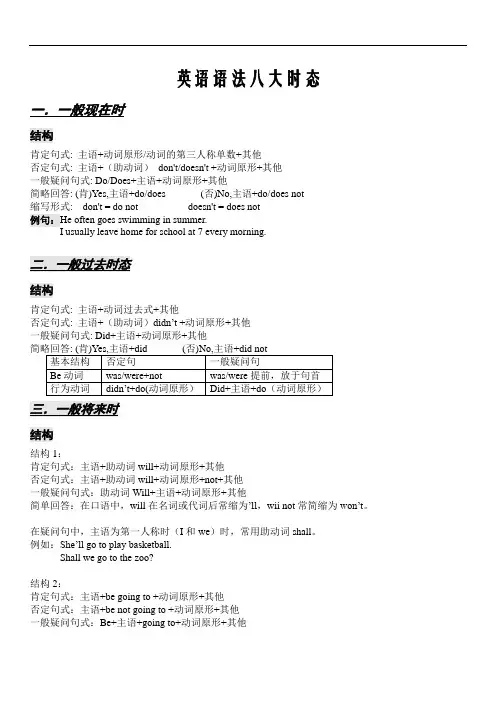
英语语法八大时态一.一般现在时结构肯定句式: 主语+动词原形/动词的第三人称单数+其他否定句式: 主语+(助动词)don't/doesn't +动词原形+其他一般疑问句式: Do/Does+主语+动词原形+其他简略回答: (肯)Yes,主语+do/does (否)No,主语+do/does not缩写形式: don't = do not doesn't = does not例句:He often goes swimming in summer.I usually leave home for school at 7 every morning.二.一般过去时态结构肯定句式: 主语+动词过去式+其他否定句式: 主语+(助动词)didn’t +动词原形+其他一般疑问句式: Did+主语+动词原形+其他基本结构否定句一般疑问句Be动词was/were+not was/were提前,放于句首行为动词didn’t+do(动词原形)Did+主语+do(动词原形)三.一般将来时结构结构1:肯定句式:主语+助动词will+动词原形+其他否定句式:主语+助动词will+动词原形+not+其他一般疑问句式:助动词Will+主语+动词原形+其他简单回答:在口语中,will在名词或代词后常缩为’ll,wii not常简缩为won’t。
在疑问句中,主语为第一人称时(I和we)时,常用助动词shall。
例如:She’ll go to play basketball.Shall we go to the zoo?结构2:肯定句式:主语+be going to +动词原形+其他否定句式:主语+be not going to +动词原形+其他一般疑问句式:Be+主语+going to+动词原形+其他简略回答:(肯)Yes,主语+be (否)No,主语+be not将来时其他表示法1)be going to表示将来表示说话人的打算、计划、安排或根据迹象判断必然或很可能发生的事情。
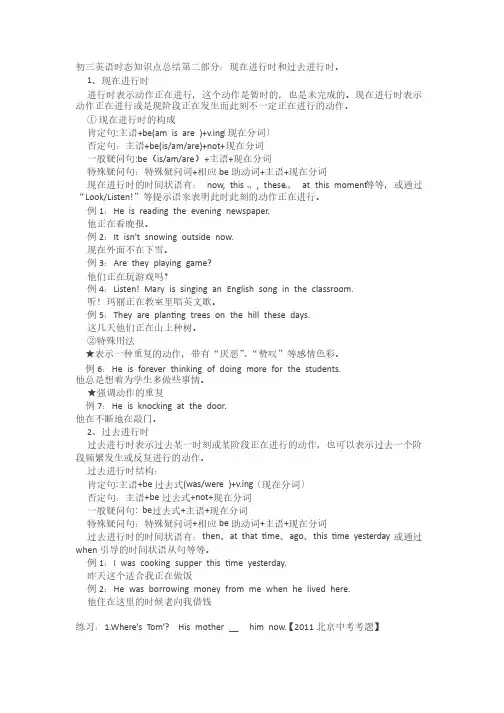
初三英语时态知识点总结第二部分:现在进行时和过去进行时。
1、现在进行时 进行时表示动作正在进行,这个动作是暂时的,也是未完成的。
现在进行时表示动作正在进行或是现阶段正在发生而此刻不一定正在进行的动作。
①现在进行时的构成 肯定句:主语+be(am is are )+v.ing〔现在分词〕 否定句:主语+be(is/am/are)+not+现在分词 一般疑问句:be(is/am/are)+主语+现在分词 特殊疑问句:特殊疑问词+相应be助动词+主语+现在分词 现在进行时的时间状语有:now, this …, these…,at this moment等等,或通过等等,或通过“Look/Listen!”等提示语来表明此时此刻的动作正在进行。
例1:He is reading the evening newspaper. 他正在看晚报。
例2:It isn't snowing outside now. 现在外面不在下雪。
例3:Are they playing game? 他们正在玩游戏吗? 例4:Listen! Mary is singing an English song in the classroom. 听!玛丽正在教室里唱英文歌。
例5:They are plan ng trees on the hill these days. 这几天他们正在山上种树。
②特殊用法★表示一种重复的动作,带有“厌恶”、“赞叹”等感情色彩。
例6:He is forever thinking of doing more for the students. 他总是想着为学生多做些事情。
★强调动作的重复例7:He is knocking at the door. 他在不断地在敲门。
2、过去进行时 过去进行时表示过去某一时刻或某阶段正在进行的动作,也可以表示过去一个阶段频繁发生或反复进行的动作。
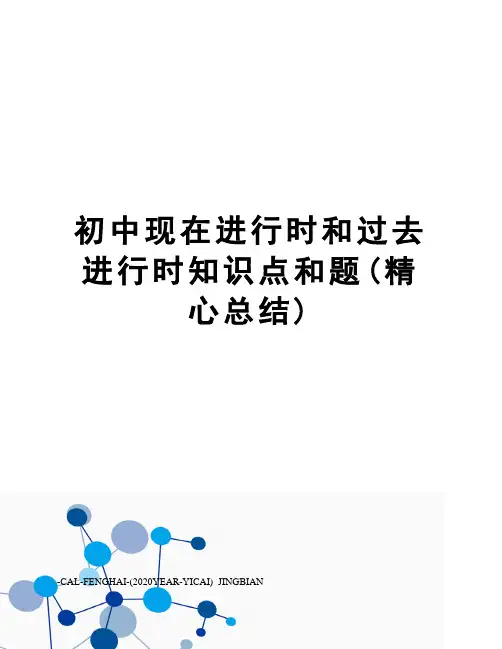
初中现在进行时和过去进行时知识点和题(精心总结)-CAL-FENGHAI-(2020YEAR-YICAI)_JINGBIAN一.现在进行时1)I am teaching English.2)She is learning to swim these days.定义:表示现在或现阶段(未必在说话时)正在进行或发生的动作或存在的状态易错点1. 结构主语 + be(is/am/are) + (not) + 现在分词 + 其他。
I am doing my homework now.They are not cooking in the kitchen.疑问句:be 提前Are you cooking now I’m hungry.What is she looking at易错点2. 现在分词1 一般情况下直接加ingstudy---studying speak---speaking say---saying carry---carrying2 以不发音的字母e结尾的单词,去掉字母e,再加ingcome---coming make---making leave---leaving have---having3 以重读闭音节(重读闭音节即两个辅音中间夹一个元音并且重读的音节)结尾,呈现“辅,元,辅”结构的动词,双写末尾的辅音字母,再加ingstop---stopping sit---sitting run---running forget---forgetting begin---beginning这类词还有:cut, get, hit, run, set, sit, spit, stop, swim, beg, drop, fit, nod, dig, forget, regret, rid, 等。
把ie改y再加ing4. die---dying tie---tying lie---lying易错点3. 时间状语时间类:now, at this moment, at present, in this month,these days 情境类:Look! Listen! Be careful!Where is Tom I can’t find him.Is there raincoat yours?eg: At the (this) moment, he is only weeping.Look! My mother is running!!!Listen! They are reading.Be careful! The car is running at you.---Where is Tom I can’t find him.---He is playing games.---Is there raincoat yours?---Mine is hanging out here.易错点4.特殊用法与 always, constantly, forvever 等词连用,表示反复发生的动作或存在的状态,往往带有说话人的主观色彩,讨厌,憎恨,惊讶,喜欢等You are always changing your mind.He is often playing the guitar. I can’t focus.现在进行时表将来, 马上,按计划将要发生的事情来来去去开始停止死come, arrive, go, leave, begin, start, stop, dieThe bus is coming.I’m going home in half an hour.我一个半小时内要回家。
初中英语语法八大时态总结完整版一、一般现在时1.定义:表示经常性或习惯性的动作、状态或真理。
2.结构:主语+动词原形(+其他成分)。
3.例句:(1) I go to school every day.(2) He often plays basketball after school.(3) Water boils at 100 degrees Celsius.二、一般过去时1.定义:表示过去一些时间发生的动作或存在的状态。
2.结构:主语+动词的过去式(+其他成分)。
3.例句:(1) They visited their grandparents last weekend.(2) She lived in Beijing when she was young.(3) We studied English in middle school.三、一般将来时1.定义:表示将来一些时间将要发生的动作或存在的状态。
2. 结构:主语 + will + 动词原形(+ 其他成分)。
3.例句:(1) I will go to the park tomorrow.(3) We will have a party next week.四、现在进行时1.定义:表示现在正在进行的动作。
2. 结构:主语 + am/is/are + 动词-ing(+ 其他成分)。
3.例句:(1) She is reading a book right now.(2) They are playing soccer in the park.(3) We are having dinner at the moment.五、过去进行时1.定义:表示过去一些时间正在进行的动作。
2. 结构:主语 + was/were + 动词-ing(+ 其他成分)。
3.例句:(1) He was watching TV at 8 o'clock last night.(2) They were traveling in Europe during summer vacation.(3) We were studying when the phone rang.六、将来进行时1.定义:表示将来一些时间正在进行的动作。
初中英语知识点总结时态初中英语时态知识点总结一、一般现在时(Simple Present Tense)一般现在时用于描述经常发生的动作、状态或普遍真理。
其构成通常是主语加上动词的原形,第三人称单数时动词要加-es/-s。
例句:- She often reads books before going to bed.(她经常在睡觉前读书。
)- The sun rises in the east.(太阳从东方升起。
)二、现在进行时(Present Continuous Tense)现在进行时表示正在进行或发生的动作。
其构成是be动词(am/is/are)加上动词的现在分词(即动词原形加-ing)。
例句:- He is playing football now.(他现在正在踢足球。
)- They are studying for the math test.(他们正在为数学考试学习。
)三、一般过去时(Simple Past Tense)一般过去时用于描述在过去某个确定时间发生的动作或状态。
动词通常在词尾加-ed,不规则动词则有特殊变化形式。
例句:- I visited my grandparents last weekend.(上周末我拜访了我的祖父母。
)- He walked to school yesterday.(昨天他走路去学校。
)四、过去进行时(Past Continuous Tense)过去进行时表示在过去某个时间点或时间段内正在进行的动作。
其构成是was/were加上动词的现在分词。
例句:- She was reading a book when I called her.(我给她打电话时,她正在读书。
)- They were playing basketball at this time yesterday.(昨天这个时候,他们在打篮球。
)五、一般将来时(Simple Future Tense)一般将来时用于描述将要发生的动作或状态。
句子种类一、句中的种类:陈述句、疑问句、感叹句 祈使句1.陈述句 (说明一个事实或陈述一个看法,有肯定句和否定句) I am a student 我是学生 I am not a student 我不是学生2.疑问句(一般疑问句、特殊疑问句、选择疑问句、反义疑问句) 1. Are you a student? 你是学生吗? 2. Do you like English ?3.What is your school like ? 你的学习怎么样?4.Do you like apple or banana ? 你喜欢苹果还是香蕉?5.He is a teacher , isn ’t he ? 他是一名老师,不是吗? 3.祈使句 (表达命令、要求、请求、劝告等,用原形)1.Be careful, boys; 请注意,男孩!2.Don’t talk in class 不要在课堂上说话 4.感叹句(由what 或how 引导的,表示惊奇、愤怒、赞赏、喜悦)1. What a good boy he is ! 他真是一个好男孩2. How good boy is ! 这个男孩多好呀 二、判断这是什么句型并翻译意思。
1. We have Chinese at eight o ’clock .2.We don ’t have maths3.Do you like maths ? Y es , I do4.What do you do at a Chinese birthday party ?动词【动词定义】:表示人或事物动作和状态的词【动词分类】:动词按照其词义和在句中的作用可为: 实义动词、连系动词、助动词和情态动词连系动词:be 、look 、keep 、get 等 助动词 :be 、do 、does 、did 、will 等 行为动词(或称实义动词):sing 、run 、like 、hate 等 情态动词 can 、could 、may 等提问: 1.举出三个系动词,并说出它的特征。
2024届九年级中考英语一轮复习【语法专题】现在进行时和过去进行时考点归纳总结(讲义)九年级英语教研室整理现在进行时现在进行时的结构:由be动词【am/ is /are】+动词的现在分词【doing】构成。
现在进行时的时态相对其它时态来说不难,记好结构,根据不同的主语,选用不同的be动词,留意标志性的词和肯定式,否定式,疑问式的句子变化,一般很快就能掌握哦。
现在进行时的用法及时间标志:一,表示此刻正在进行或发生的动作。
常连用的标志词有now,at this moment或提示语look, listen等She is cooking In the kitchen.她正在厨房做饭。
My father is watching TV now.我父亲正在看电视。
What are you doing,Amy?艾米,你在做什么?I'm writing an email to my friend.我在给我的朋友写邮件呢。
Listen! They are singing a song.听! 他们在唱歌。
二,表示当前一段时间内的活动或现阶段正在进行的动作或持续的状态,常见的标志词有these days ,all the time。
Hi ,I haven't see you here for a long time.你好,我好久没在这里见过你了。
I'm writing a book about how to use puter these days.我这些天一直在写一本关于如何使用电脑的书。
They are running and jumping all the time.他们一直又跑又跳。
三,有些动词表感觉的感官动词hear/smells/see/ notice等,和表态度,情感,心理状态的词like/ want/ hope/ know没有进行时态。
注意,always用于现在进行时表示强烈的感情色彩,例如喜好,厌恶等He's always plaining.他总是抱怨。
初中英语基本时态总结Ⅰ、一般现在时1、概念:1)表示经常性或习惯性的动作,常与表示频度的时间状语连用。
时间状语:always, usually, often, sometimes, seldom, never, every day, twice a week, on Sunday, etc.(提问用How often)例:I leave home for school at 7 every morning.Tom gets up at 6:00 every morning.2)客观真理,客观存在,科学事实。
例:The earth moves around the sun. 地球绕太阳转动。
Shanghai lies in the east of China. 上海位于中国东部。
3)格言或警句。
例:Pride goes before a fall. 骄者必败。
注意:宾语从句中,即使主句是过去时,从句谓语是客观真理也要用一般现在时。
例:Columbus proved that the earth is round. 哥伦布证实了地球是圆的。
2、结构:表状态S+ am/is/are+ P (句中有实义动词不用be)表动作S+V原+O (若主语是单三人称,谓动加s/es。
)3、句式变化:变疑问,有be把be提到主语前;无be在主语前加do/does,谓动变为原形。
变否定,有be在be后加“not”;无be在主语后加don’t/doesn’t,谓动变为原形。
例:①They are in the classroom. →Are they in the classroom? Yes, they are./No, they aren’t. →They aren’t in the classroom②He often waters the flowers . → Does he often water the flowers?Yes, he does. / No, he doesn’t. →He doesn’t often water the flowersⅡ、一般过去时1、概念:1)表示在确定的过去时间里所发生的动作或存在的状态。
英语时态初中归纳总结初中英语时态的归纳总结主要包括以下八种时态,每种时态都有其特定的概念、时间状语、基本结构、否定形式以及一般疑问句的形式。
1. 一般现在时概念:表示经常、反复发生的动作或行为及现在的某种状况。
时间状语:always, usually, often, sometimes, every week (day, year, month…), once a week, on Sundays等。
基本结构:主语+ be动词(am/is/are)+ 其他主语+ 行为动词+ 其他否定形式:主语+ am/is/are + not + 其他主语为第三人称单数时,行为动词前加doesn't,并还原行为动词一般疑问句:把be动词放于句首用助动词do(主语为第三人称单数时用does)提问,并还原行为动词2. 一般过去时概念:表示过去某个时间里发生的动作或状态;过去习惯性、经常性的动作、行为。
时间状语:ago, yesterday, the day before yesterday, last week(year, night, month…), in 1989, just no w, at the age of 5, one day, long long ago, once upon a time等。
基本结构:主语+ be动词(was/were)+ 其他主语+ 行为动词(过去式)+ 其他否定形式:主语+ was/were + not + 其他在行为动词前加didn't,并还原行为动词一般疑问句:was或were放于句首用助动词do的过去式did提问,并还原行为动词3. 现在进行时概念:表示现阶段或说话时正在进行的动作及行为。
时间状语:now, at this time, these days等。
基本结构:主语+ am/is/are + doing + 其他否定形式:主语+ am/is/are + not + doing + 其他一般疑问句:把be动词放于句首4. 过去进行时概念:表示过去某段时间或某一时刻正在发生或进行的行为或动作。
一.现在进行时1)I am teaching English.2)She is learning to swim these days.定义:表示现在或现阶段(未必在说话时)正在进行或发生的动作或存在的状态易错点1. 结构主语+ be(is/am/are)+ (not) + 现在分词+ 其他。
I am doing my homework now.They are not cooking in the kitchen.疑问句:be 提前Are you cooking now? I’m hungr y.What is she looking at?易错点2. 现在分词1 一般情况下直接加ingstudy---studying speak---speaking say---saying carry---carrying2 以不发音的字母e结尾的单词,去掉字母e,再加ingcome---coming make---making leave---leaving have---having 3 以重读闭音节(重读闭音节即两个辅音中间夹一个元音并且重读的音节)结尾,呈现“辅,元,辅”结构的动词,双写末尾的辅音字母,再加ingstop---stopping sit---sitting run---running forget---forgetting begin---beginning这类词还有:cut, get, hit, run, set, sit, spit, stop, swim, beg, drop, fit, nod, dig, forget, regret, rid, 等。
把ie改y再加ing4. die---dying tie---tying lie---lying易错点3. 时间状语时间类:now, at this moment, at present, in this month,these days情境类:Look! Listen! Be careful!Where is Tom? I can’t find him.Is there raincoat yours?eg: At the (this) moment, he is only weeping.Look! My mother is runningListen! They are reading.Be careful! The car is running at you.---Where is Tom? I can’t find him.---He is playing games.---Is there raincoat yours?---Mine is hanging out here.易错点4.特殊用法与always, constantly, forvever 等词连用,表示反复发生的动作或存在的状态,往往带有说话人的主观色彩,讨厌,憎恨,惊讶,喜欢等You are always changing your mind.He is often playing the guitar. I can’t focus.现在进行时表将来, 马上,按计划将要发生的事情来来去去开始停止死come, arrive, go, leave, begin, start, stop, dieThe bus is coming.I’m going home in half an hour.我一个半小时内要回家。
练习:1. Who _____ over there now?A. singingB. are singC. is singingD. sing2. It’s eight o’clock. The students _____ an English class.A. haveB. havingC. is havingD. are having3. Listen! The baby _____ in the next room.A. cryingB. criedC. is cryingD. cries4. Look! The twins _____ new sweaters.A. are wearingB. wearingC. are wearD. is wearing5. Don’t talk here. Grandparents _____.A. is sleepingB. are sleepingC. sleepingD. sleep6. --- Hu rry up! We’re all waiting for you.--- I ______ for an important phone. Go without me.A. waitB. was waitingC. am waitingD. waited7. --- Is this your hat?--- No, mine ______ there behind the door.A. has hungB. is hangingC. hungD. will hang8. –When_____he_____back? – Sorry, I don’t know.A. does,comeB.are comingC.is comeD.is coming六、过去进行时1) She was reading a book at 8 a.m. this morning.2) They are shopping from 8 to 9 last night.定义:表示过去某个时刻或过去某个阶段正在进行或发生的动作或存在的状态易错点1. 结构主语+ be ( was/were) + (not) + 动词现在分词+ 其他be 体现过去时态,doing 表示动作进行We were having a meeting this time yesterday.What were you doing when I called you?疑问句:was/were 提前易错点2. 常用时间状语,特殊用法this morning , the whole morning, all day yesterday, this time last night, from 2 to 4 yesterday,when, whileMy brother fell and hurt himself while he was riding his bike.she was making cakes when her mother arrived at home.When, while 都表示“当……时”的时候,while 后一般都是进行时态,when 后可加任何时态,但考试时候,多考when 后加一般时态,while 后加进行时态的辨析。
具体情况具体分析,还考情商1. She_________ apples in her garden when I_________ to see her yester day. BA. picked,wentB. was picking, wentC. picked,was goingD. was picking,was going2. I ____ an old friend of mine when I ______ in the street yesterday after noon . AA. met... was walkingB. was meeting ... walkedC. was meeting ... was walkingD. met ... walked3. While she ______ TV in the sitting room , the bell ______ . CA. watches , ringsB. is watching ,rangC. was watching ,rangD. watched ,was ringing4. The little girl was ______ her cat while her mother was _____ the pian o . CA. playing ,playingB. playing ,playing withC. playing with ,playingD. playing with ,playing with2. 宾语从句,主过从过She said that she was sleeping at 8:00.练习:( )1. What _____ your grandfather _____ this time yesterday ?A. is ... doingB. was ... doingC. did .. doD. had ... done( )2. ____ you ______ a meeting at four yesterday afternoon ?A. Were ... havingB. Was ... havingC. Did ... haveD. Do ... have ( )3. A: I called you at about half past eight last night , but nobody answe red .B: Oh , I ______ in my office at that time .A. will workB. was workingC. workedD. had worked( )4. His family _____ TV from ten to twelve last night .A. watchedB. were watchingC. had watchedD. was watching( )5. A: Hi , Lin Tao . I didn’t see you at the party .B: Oh, I ________ ready for the maths exam .A. am gettingB. was gettingC. gotD. have got( )6. A: I called you yesterday evening ,but there was no answer.B: Oh ,I am sorry I ________ dinner at my friend’s home.A.have B.had C.was having D.have had( )7. A: Did you notice him come in?B: No. I _____ a football game.A. have watchedB. had watchedC. am watchingD. was watching ( )8. You must tell us what you _______ at ten yesterday evening .A. didB. was doingC. were doneD. were doing( )9. It was Friday evening. Mr and Mrs. Green _____ ready to fly to En gland.a. are gettingb. getc. were gettingd. got( )10. A: How did the accident happen ?B: You know , it ______ difficult to see the road clearly because it _____ .A. was , was rainingB. is , has rainedC. is, is rainingD. will be ,will rain( )11. One day when I _______ the post office , I _____ my uncle . A. pass... say B. was passing ... sawC. passed ... was seeingD. am passing ... am seeing( )12. The student ______ to move the bag of rice _______ he heard the sound of a motorbike .A. was running... whenB. was running ... whileC. runs ... whenD. ran ... while( )13. Mark ________ while he ________ up and down.A. falls...is jumpingB. fell...was jumpingC. was falling...was jumpingD. felt...was jumping( )14. He said he _____ to draw a plane on the blackboard at that time.a. triesb. triedc. was tryingd. will try( ) 15. His parents wanted to know how he _____ on with his new classmates.a. was gettingb. getsc. is gettingd. will get( )16. He asked _______ outside .A. who are singingB. who was singingC. who singing wasD. who is singing。